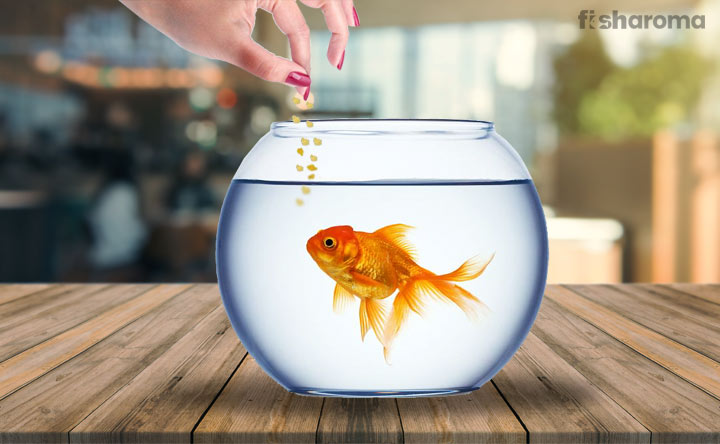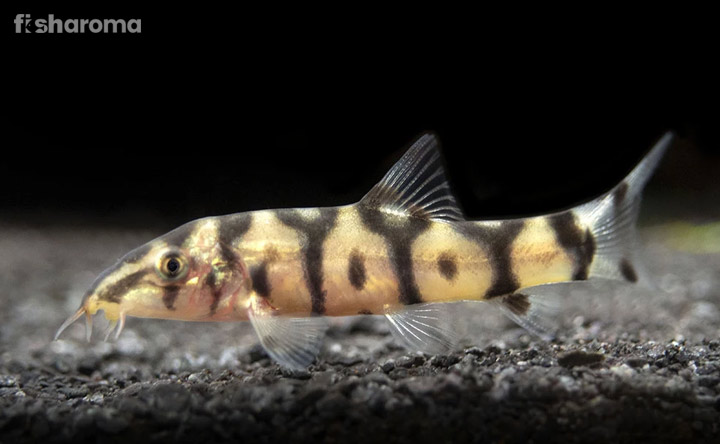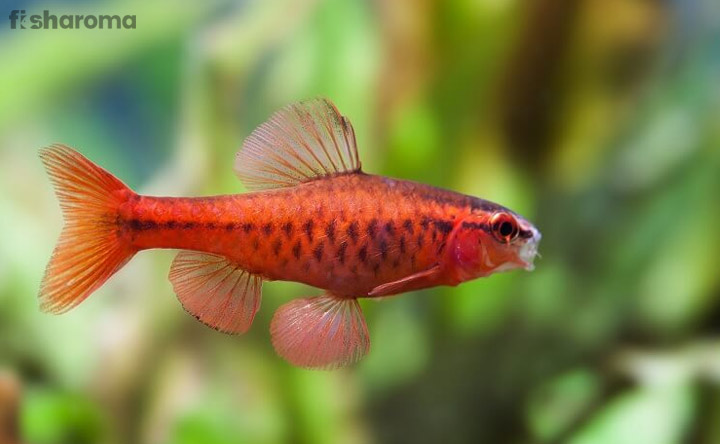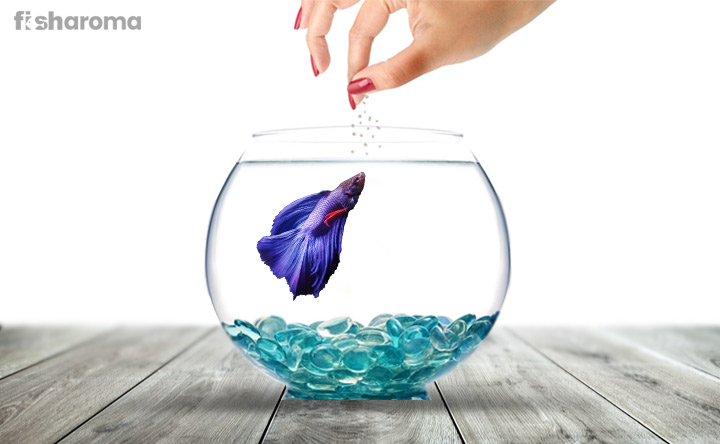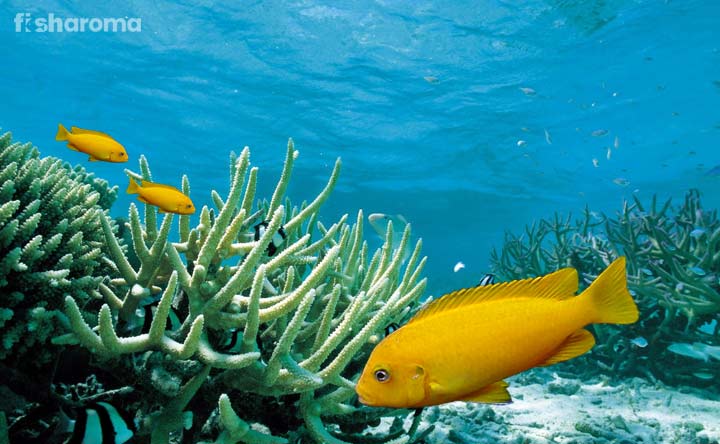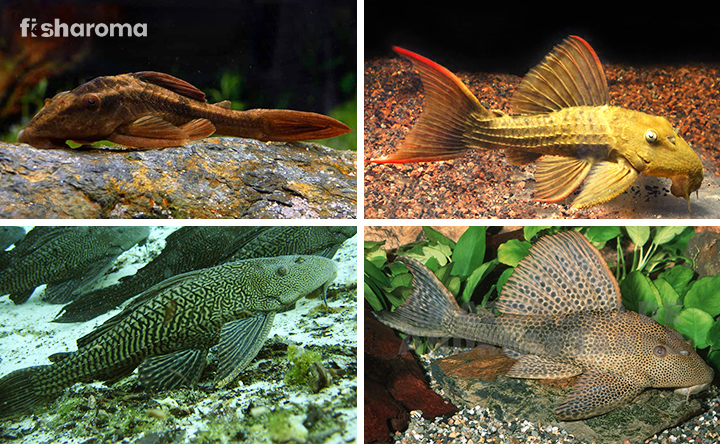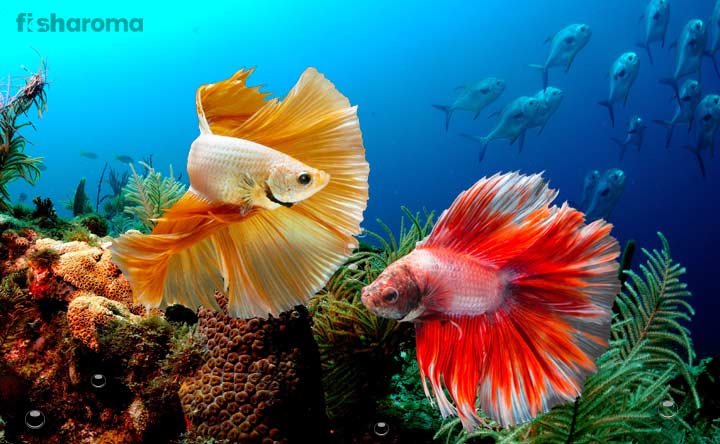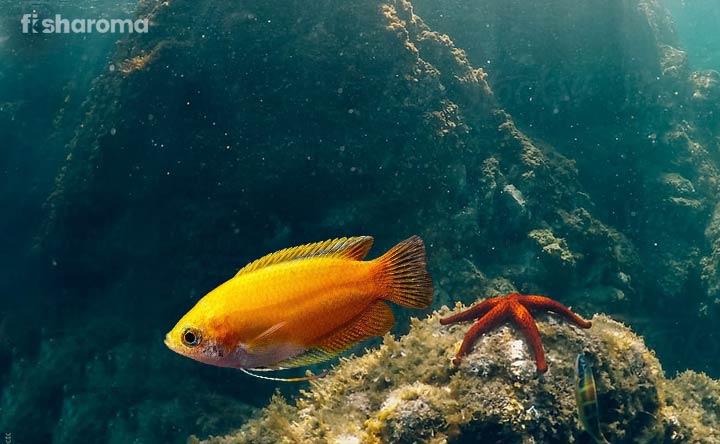Convict Cichlid –The Complete Care Guide for Your Swimmer-Friend
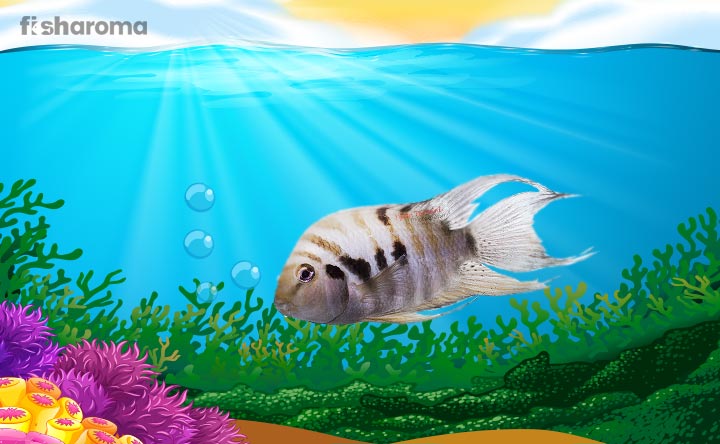
- Origin of Convict Cichlid
- Convict Cichlid Appearance
- Tank Requirements for Convict Cichlid
- Water Type for Convict Cichlid
- Convict Cichlid Temperament
- Suitable Tankmates for Convict Cichlid
- Convict Cichlid Breeding
- Dietary Requirements of Convict Cichlid
- Diseases of Convict Cichlid with Interventions
- Types of Cichlids
Some people know Convict Cichlid as Zebra Cichlid – the most important member of the Cichlidae family. Incredibly hardy and easy to care, this Zebra-lined fish is an aggressive breed but it’s still a good pet for the beginners because of its less-demanding and adjustable nature. Convict Cichlid has got its name because of the white stripes in a vertical black body.
Quick Details about Convict Cichlid
Before choosing this freshwater fish for your fish tank, why don’t you gather a little information on Convict Cichlid in the given table:
| Scientific Name | Amatitlania nigrofasciata |
| Origin | Central America |
| Life-Span | 8+ Years |
| Color | White, Black |
| Temperament | Aggressive |
| Size | Up to 6” (15.24 cm) |
| Diet | Omnivore |
| Family | Cichlidae |
| Compatibility | Less Compatible |
| Tank Size | 30 Gallons |
| Care Level | Moderate |
Overview
Located in the warm river, this hardy fish is capable to dwell in every type of fish tank, but don’t keep marine water in the aquarium of this freshwater species. You don’t need to take much care of this vibrant-shaded fish because they have no special food requirement, and they are smaller in size. You can purchase this fish at $5.88-$12.88.
Origin of Convict Cichlid
This American fish is found both in the hot geysers of hilly areas and warm streams of the land region under the rocks and sunken branches. Aquarists also collect this fish from Panama, Guatemala, Nicaragua, Costa-Rica, Australia, and Honduras. Generally, these fish are bottom-dwellers and love to live at the bed of the fish tank on small rocks or gravels.
Convict Cichlid Appearance
This fish just looks like Zebra with black and white color in its entire body. The body of the species is white with black striped-bands on it. The adult Cichlid has eight or nine black stripes on its body and the juvenile fish has fewer stripes than the adult fish.
The male fish has larger dorsal and anal fins with bright coloration than the female breed. Even the males grow up to 6”, whereas the females can only grow up to 4.5”. Usually, you will find a black and white Convict Cichlid, but pink and yellow Cichlids are also found with no vertical stripes in their body. The female Cichlids have more stripes than male fish.
Tank Requirements for Convict Cichlid
Convict Cichlid loves dwelling in slow-moving water on the bed of the rocky substrates. In the wild, these fish will be found hiding behind rock-patterns and branches. So, you need to create a similar ambiance when you are petting a Convict Cichlid. Set the fish tank as per the comfort of your pet Cichlid by considering these suggestions:
Tank Size
You need to purchase a 30-gallon aquarium for this 6” fish because it needs a spacious area to dwell, and without space, it cannot have a great lifespan.
Ornaments
You can also keep driftwood in the tank because Cichlid loves consuming the algae on the driftwood. Keep plants like Java Fern and Amazon Swords in the aquarium because Cichlids like to live in an environment that is surrounded by greenery.
Filter
Keep a good filter in the tank, so that the impurities get washed out from the tank with the help of the aquarium filter. You may also set an artificial slow-current system in the aquarium because Cichlid enjoys slow current in wild rivers.
Lighting
Set a fluorescent bulb on the ceiling of the aquarium. Moderate lighting better for Convict Cichlid, so you don’t need to bring high-powered light.
Water Type for Convict Cichlid
We know that water is the home of every fish, so try to follow some necessary points before you set the water in a Cichlid tank:
Temperature
Keep the water temperature from 79°-84°F (26-28 °C) for this tropical fish.
pH Level
The pH level should be 6.6-7.8.
Hardness
The carbonate hardness of the water should be 180-240 ppm.
Cleaning Method
The hobby of fishkeeping sounds fascinating but it is not
very easy to maintain the necessities of pet fish. Along with the maintenance
of water quality, you also need to clean the entire tank whenever it turns
dirty.
Wash out the tank and the objects with a soft brush and
liquid soap. After that wash it off with clean water and wipe the entire tank
with a thick cloth to avoid the marks of water on the glass tank.
Replacement Process
It is quite natural that the replacement process requires a
lot of time but it is necessary to do once in a month to maintain the quality
of the water. While changing the water keep in the mind that the fish not be
harmed and change about 10% of water if you are doing the replacement weekly.
You can change 20-25% of water if you are changing the water
once a month. However, after the completion of the process when you are setting
the tank in a novel way, maintain the water temperature, pH level, hardness,
and other necessary things.
Convict Cichlid Temperament
Convict Cichlid is infamous for its territorial and aggressive behavior, but it is active compared to other species. However, other Cichlids may not be violent but their behavior is wilder than other fish. If you keep wrong and less compatible fish with Convict Cichlid, then it may chase or harass them or vice-versa. So be cautious before choosing proper tankmates for this fish.
They have fantastic parenting ability because they know how to protect their eggs and newly-hatched babies. Moreover, they love to stay in a dark hiding place, so they dwell under the caves, trees and behind the rocks.
Suitable Tankmates for Convict Cichlid
We have discussed at the beginning that Convict Cichlid is a territorial and aggressive fish. Don’t get wrong ideas about its temperament by seeing its timid size. Usually, this fish is hostile in nature and likes to live alone. Moreover, this breed prefers living on its own territory with different fish of the same family.
Avoid keeping other aggressive water species in the fish tank with Cichlids. Try to find out less-aggressive fish in an aquarium. Take a look at some of the most compatible tankmates for Convict Cichlid:
- Giant Danio
- Green Terror
- Pictus Catfish
- Jack Dempsey
- Jewel Cichlid
- Firemouth Cichlid
During the spawning period, the aggression of this fish gets worse, so don’t keep them with other fish during the time of mating and laying eggs. Try to keep Cichlid in another tank during the reproduction process.
Convict Cichlid Breeding
According to the study done by expert aquarists, Convict Cichlids are very good and highly-protective parents for their children. You need to be sure that you have a separate big aquarium in your home which you can use for the breeding process of a Cichlid.
At the age of seven months, Convict Cichlid gets sexually matured and ready to lay eggs. You just need to pair a male and a female fish in a separate tank and let them spawn all year around. The females lay their eggs on the rocks or inside the caves. So, keep small caves and rocks on which the female fish can lay eggs. The temperature of the water during the reproduction time should be 84°F.
After the fertilization of the eggs by the male fish, the female fish protects the eggs till the time of development. Moreover, the father and mother of the little Cichlids bring food for their little fries after the development of the eggs. After five days of the development, the little fish start swimming.
Arrange a 50-gallon separate tank if you want to encourage the mating and breeding of Convict Cichlid because a male Cichlid takes the entire space in the tank during spawning and egg-fertilization period.
Dietary Requirements of Convict Cichlid
Convict Cichlid is an omnivorous fish as mentioned above. So, the fish keepers don’t need to worry much about the dietary requirements of the fish. You just need to arrange simple foods for Convict Cichlid such as:
- Mosquito Larvae
- Plant Debris
- Small Insects
- Black Worms
- Brine Shrimp
- Blood Worms
- Daphnia
- Tubifex
- Spirulina
- Broccoli
- Carrots
- Lettuce
There are other frozen foods that you will get in the market such as:
- API for Large Cichlids
- Hikari Cichlid Gold
- Big Fella Stick
- JumboKrill
While feeding the fish, make sure that you are feeding them two to three times a day in less amount, and the tank water should be cleaned when the foods float in the water. If you don’t change the water then the rotten foods will infect the entire tank.
Diseases of Convict Cichlid with Interventions
Health issues are a common part of life for every living thing. Therefore, fish also have different types of health and mental issues. Some common illnesses of Convict Cichlid are:
- Stress
- Fungal Infection
- Hexamita
- Insomnia
So, if you want your pet fish to stay away from these health problems then keep the water of the tank clean; give your finned friends a good environment; keep suitable tankmates with them and consult a veterinary doctor for the solution. A veterinary doctor also suggests antifungal medication for Convict Cichlid to keep it fresh and healthy.
Types of Cichlids
There are innumerable Cichlids like Convict Cichlid which you can keep in your fish tank. Different species have specific features and characteristics. Some of the members of the Cichlid family are as follows:
- Electric Blue Cichlid – Another name of this fish is ‘Mouthbrooding Malawi Cichlid’. Famous for its attractive blue color, Electric Blue Cichlid is an eye-catcher to different fish enthusiasts. This semi-aggressive fish prefers to live in soft water and its small size helps the aquarists tackle this fish easily.
- Cockatoo Cichlid – This multi-shaded South American fish is shaded with yellow and orange hues on the dorsal fins. Cockatoo Cichlid is an aggressive fish which needs 20-gallons aquarium to live. The water of the tank should be mildly acidic, and the decoration should be surrounded by caves. It is easy to pet this fish.
- Peacock Cichlid – Originated from Lake Malawi, Peacock Cichlid is one of the amazing fish of freshwater. The males are shaded with orange and blue, whereas the females are multi-colored.
- Yellow Lab Cichlid – This mouthbrooding yellow Cichlid belongs to Mbuna varieties. This fish prefers a dwelling with their mate partner. They are peaceful fish and easy to care, so as a beginner, you can easily pet this fish in your tank.
- Oscar Cichlid – This is the most aggressive member in a cichlid group, large in size up to 13” (33 cm) and need minimum 30-40 gallons aquarium to live. These fish are semi-aggressive and need an isolated place to dwell.
- Jewel Cichlid – This African fish is the crowning glory of a small fish tank. Fish enthusiasts love petting this fish because of its attractive beauty.
- Firemouth Cichlid – This fish has red-shaded throat and big mouth, so it is known as Firemouth Cichlid. This is a large breed but easy to care because of its peaceful nature.
- Jack Dempsey Cichlid – Living in Central America, this fish likes living in cold water. For the novice aquarists, this fish is the best choice but don’t keep small fish with this large breed because Jack Dempsey has the tendency of eating small water species.
- Venustus Cichlid – You will find this yellow-blue fish in cold lakes and wild streams. People like to keep this fish in their aquarium because of the beautiful shape, pattern, and color.
- Frontosa Cichlid – This hump-headed fish is found in the flower shape and relatively calm in nature. But this large size fish needs 200+ gallons aquarium to live.
- Kribensis Cichlid – This easy-natured fish is bright red in color and needs a minimum of 20+ gallon aquarium to live.
Care Guide for Convict Cichlid
Eating, sleeping, and dwelling are the major things every living being want to enjoy a healthy life. Same in the case of fish because they also want a clean and natural environment to live and good foods to eat. So as a fish keeper, your prime duties are to keep the fish home clean, provide proper nutrition to your swimmer-companion and help them in laying eggs comfortable. If you take proper care of your little buddies then their life span will increase with a better living condition.
Interesting Facts about Cichlid
- There are more than 1,700 species in the Cichlid family.
- In the wild river, Cichlid can live up to 20 years.
- They are both diurnal and nocturnal species.
- Not only in America but you will also get this fish in the lakes of Africa.
More Ideas about Other Fish
Take a look at some of the other aquatic species for your aquarium:
- Silver Arowana: This South American tropical river fish is attractive because of the silvery beauty, and if you wish then you can keep this fish in your aquarium.
- Siamese Fighting-Fish: Another name of Siamese Fighting Fish is Betta which is infamous for aggression but famous for its beautiful looks.
- Pictus Catfish: This is the small member of the Catfish family located in the Amazon river and also popular as a tank-cleaner water species.

